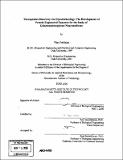| dc.contributor.advisor | Ram Sasisekharan. | en_US |
| dc.contributor.author | Prabhakar, Vikas | en_US |
| dc.contributor.other | Massachusetts Institute of Technology. Biological Engineering Division. | en_US |
| dc.date.accessioned | 2008-03-26T20:27:56Z | |
| dc.date.available | 2008-03-26T20:27:56Z | |
| dc.date.issued | 2006 | en_US |
| dc.identifier.uri | http://dspace.mit.edu/handle/1721.1/38917 | en_US |
| dc.identifier.uri | http://hdl.handle.net/1721.1/38917 | |
| dc.description | Thesis (Ph. D.)--Massachusetts Institute of Technology, Biological Engineering Division, 2006. | en_US |
| dc.description | "June 2006." | en_US |
| dc.description | Includes bibliographical references. | en_US |
| dc.description.abstract | Glycans are chemically heterogeneous macromolecules that have profound importance in a variety of biological processes. Located at the surfaces of cells, deposited in the extracellular matrix, or attached to soluble signaling agents, these molecules are characterized by a structural complexity that has thus far prevented their widespread exploitation in biomedicine. Insight into the fine structure and sequence of these complex biomolecules provides a novel niche for the development of therapeutic interventions. Such an understanding is rapidly accumulating via the molecular cloning, recombinant genetic expression, and protein purification of glycosaminoglycan-degrading enzymes. To this end, enzymes from the chondroitinase family of Pedobacter heparinus and Proteus vulgaris were developed. This library of enzymatic tools will reveal glycoconjugate structure-function motifs, allowed for by structural elucidation of glycan species using coupled bioinformatics/analytical chemistry techniques centered on mass spectrometry, nuclear magnetic resonance, and capillary electrophoresis. | en_US |
| dc.description.abstract | (cont.) Biochemical characterization of these enzymes has allowed for the rational genetic manipulation of substrate recognition and binding site amino acid residues, producing site-directed protein engineered mutants with altered action pattern and substrate specificity. Progress in these areas will allow for the elucidation of critical roles of glycans in the biological regulation of growth factors, morphogens, cytokines, and cell-surface proteins. This extension of the capabilities of glycan analytical biotechnologies will help to translate basic science glycobiology to applied glycomedicine and drug discovery. | en_US |
| dc.description.statementofresponsibility | by Vikas Prabhakar. | en_US |
| dc.format.extent | 203 p. | en_US |
| dc.language.iso | eng | en_US |
| dc.publisher | Massachusetts Institute of Technology | en_US |
| dc.rights | MIT theses are protected by copyright. They may be viewed, downloaded, or printed from this source but further reproduction or distribution in any format is prohibited without written permission. | en_US |
| dc.rights.uri | http://dspace.mit.edu/handle/1721.1/38917 | en_US |
| dc.rights.uri | http://dspace.mit.edu/handle/1721.1/7582 | en_US |
| dc.subject | Biological Engineering Division. | en_US |
| dc.title | Therapeutics discovery via glycotechnology : the development of protein engineered enzymes for the study of galactosaminoglycan neuromedicine | en_US |
| dc.title.alternative | Development of protein engineered enzymes for the study of galactosaminoglycan neuromedicine | en_US |
| dc.type | Thesis | en_US |
| dc.description.degree | Ph.D. | en_US |
| dc.contributor.department | Massachusetts Institute of Technology. Department of Biological Engineering | |
| dc.identifier.oclc | 146329977 | en_US |
